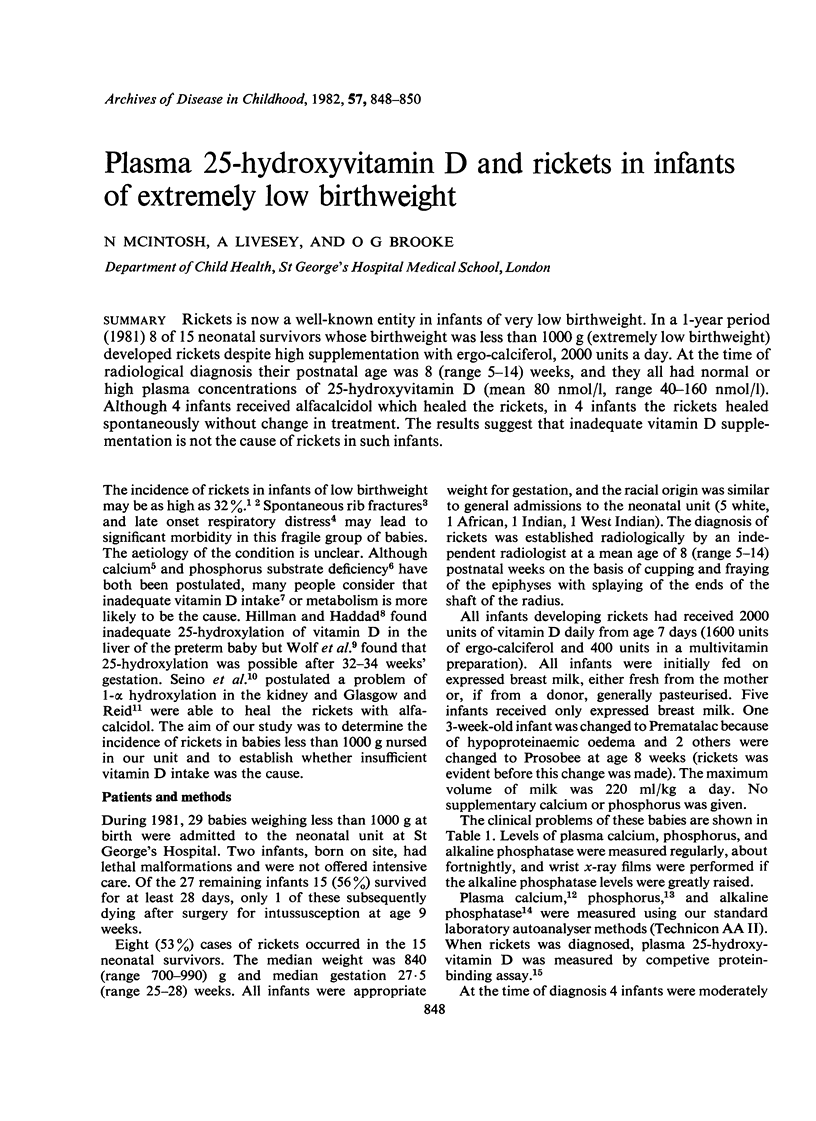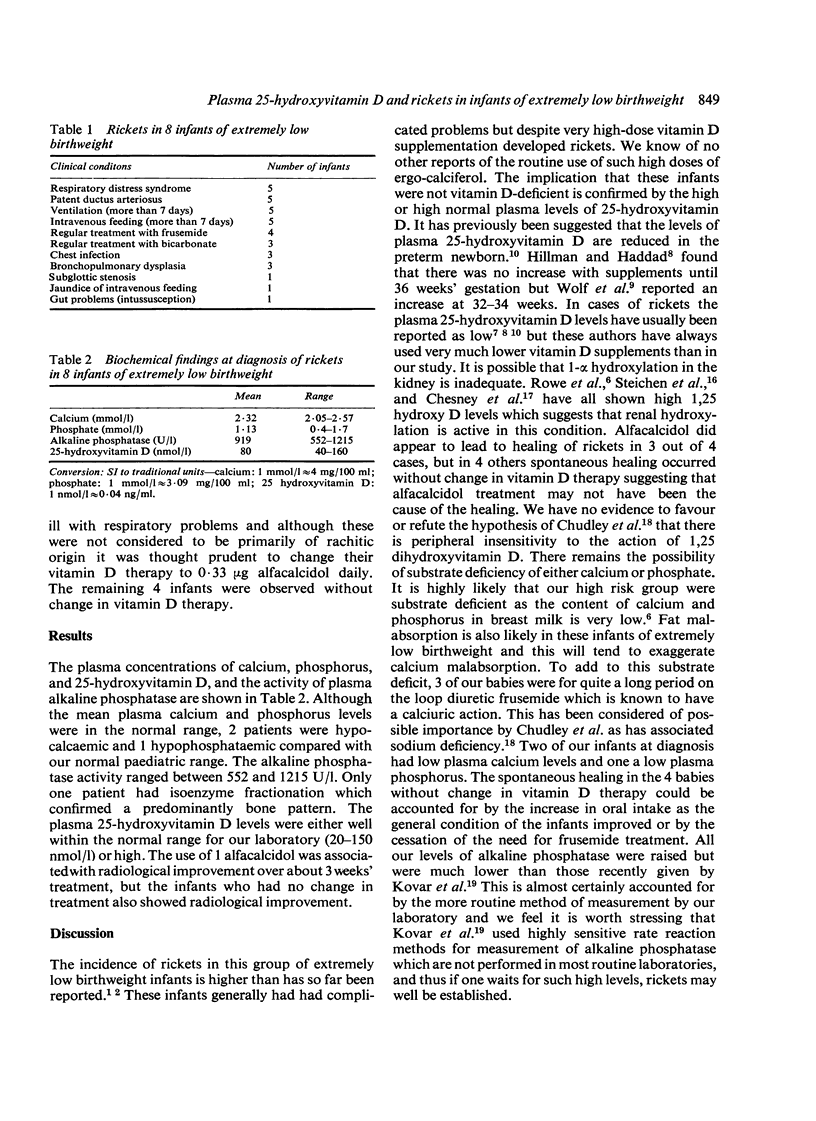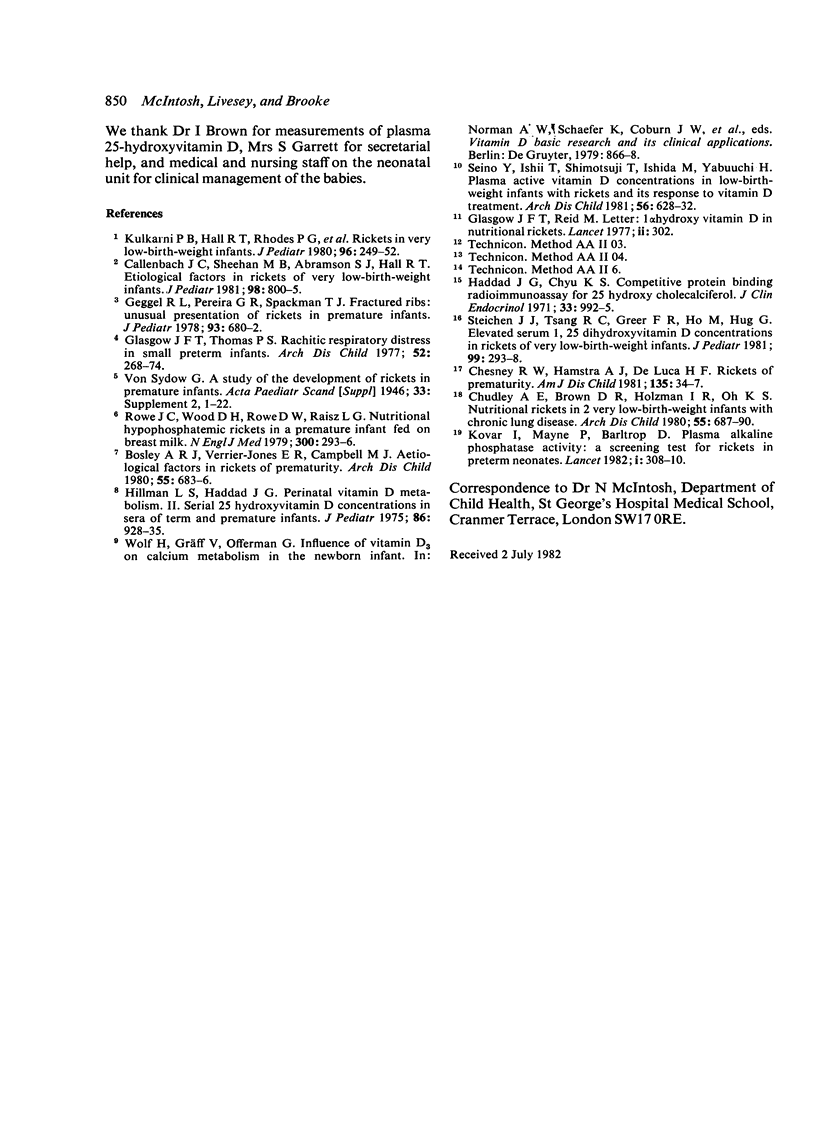Abstract
Rickets is now a well-known entity in infants of very low birthweight. In a 1-year period (1981) 8 of 15 neonatal survivors whose birthweight was less than 1000 g (extremely low birthweight) developed rickets despite high supplementation with ergo-calciferol, 2000 units a day. At the time of radiological diagnosis their postnatal age was 8 (range 5-14) weeks, and they all had normal or high plasma concentrations of 25-hydroxyvitamin D (mean 80 nmol/l, range 40-160 nmol/l). Although 4 infants received alfacalcidol which healed the rickets, in 4 infants the rickets healed spontaneously without change in treatment. The results suggest that inadequate vitamin D supplementation is not the cause of rickets in such infants.
Full text
PDF


Selected References
These references are in PubMed. This may not be the complete list of references from this article.
- Bosley A. R., Verrier-Jones E. R., Campbell M. J. Aetiological factors in rickets of prematurity. Arch Dis Child. 1980 Sep;55(9):683–686. doi: 10.1136/adc.55.9.683. [DOI] [PMC free article] [PubMed] [Google Scholar]
- Callenbach J. C., Sheehan M. B., Abramson S. J., Hall R. T. Etiologic factors in rickets of very low-birth-weight infants. J Pediatr. 1981 May;98(5):800–805. doi: 10.1016/s0022-3476(81)80852-9. [DOI] [PubMed] [Google Scholar]
- Chudley A. E., Brown D. R., Holzman I. R., Oh K. S. Nutritional rickets in 2 very low birthweight infants with chronic lung disease. Arch Dis Child. 1980 Sep;55(9):687–690. doi: 10.1136/adc.55.9.687. [DOI] [PMC free article] [PubMed] [Google Scholar]
- Geggel R. L., Pereira G. R., Spackman T. J. Fractured ribs: unusual presentation of rickets in premature infants. J Pediatr. 1978 Oct;93(4):680–682. doi: 10.1016/s0022-3476(78)80916-0. [DOI] [PubMed] [Google Scholar]
- Glasgow J. F., Reid M. 1 alpha-hydroxyvitamin D in nutritional rickets. Lancet. 1977 Aug 6;2(8032):302–302. doi: 10.1016/s0140-6736(77)90988-6. [DOI] [PubMed] [Google Scholar]
- Glasgow J. F., Thomas P. S. Rachitic respiratory distress in small preterm infants. Arch Dis Child. 1977 Apr;52(4):268–273. doi: 10.1136/adc.52.4.268. [DOI] [PMC free article] [PubMed] [Google Scholar]
- Haddad J. G., Chyu K. J. Competitive protein-binding radioassay for 25-hydroxycholecalciferol. J Clin Endocrinol Metab. 1971 Dec;33(6):992–995. doi: 10.1210/jcem-33-6-992. [DOI] [PubMed] [Google Scholar]
- Hillman L. S., Haddad J. G. Perinatal vitamin D metabolism. II. Serial 25-hydroxyvitamin D concentrations in sera of term and premature infants. J Pediatr. 1975 Jun;86(6):928–935. doi: 10.1016/s0022-3476(75)80231-9. [DOI] [PubMed] [Google Scholar]
- Kovar I., Mayne P., Barltrop D. Plasma alkaline phosphatase activity: a screening test for rickets in preterm neonates. Lancet. 1982 Feb 6;1(8267):308–310. doi: 10.1016/s0140-6736(82)91569-0. [DOI] [PubMed] [Google Scholar]
- Kulkarni P. B., Hall R. T., Rhodes P. G., Sheehan M. B., Callenbach J. C., Germann D. R., Abramson S. J. Rickets in very low-birth-weight infants. J Pediatr. 1980 Feb;96(2):249–252. doi: 10.1016/s0022-3476(80)80814-6. [DOI] [PubMed] [Google Scholar]
- Rowe J. C., Wood D. H., Rowe D. W., Raisz L. G. Nutritional hypophosphatemic rickets in a premature infant fed breast milk. N Engl J Med. 1979 Feb 8;300(6):293–296. doi: 10.1056/NEJM197902083000607. [DOI] [PubMed] [Google Scholar]
- Seino Y., Ishii T., Shimotsuji T., Ishida M., Yabuuchi H. Plasma active vitamin D concentration in low birthweight infants with rickets and its response to vitamin D treatment. Arch Dis Child. 1981 Aug;56(8):628–632. doi: 10.1136/adc.56.8.628. [DOI] [PMC free article] [PubMed] [Google Scholar]
- Steichen J. J., Tsang R. C., Greer F. R., Ho M., Hug G. Elevated serum 1,25 dihydroxyvitamin D concentrations in rickets of very low-birth-weight infants. J Pediatr. 1981 Aug;99(2):293–298. doi: 10.1016/s0022-3476(81)80481-7. [DOI] [PubMed] [Google Scholar]


